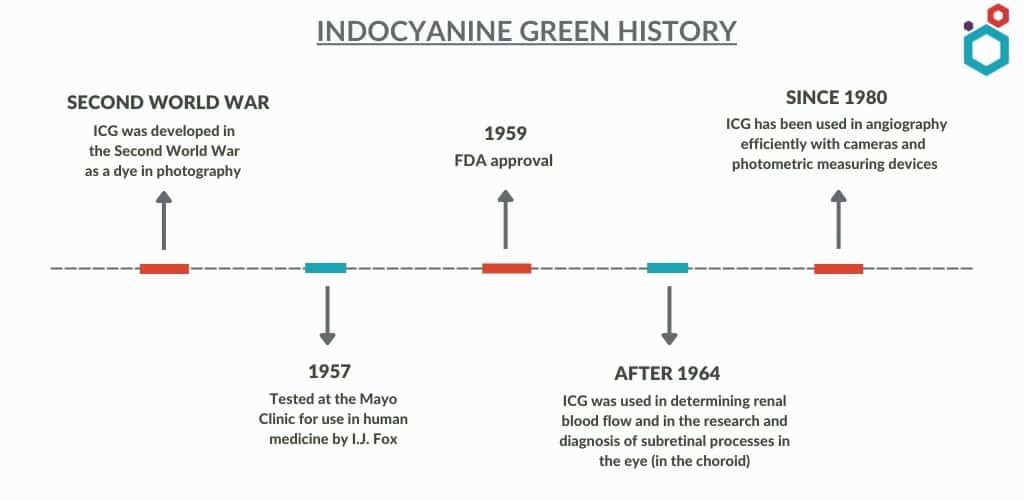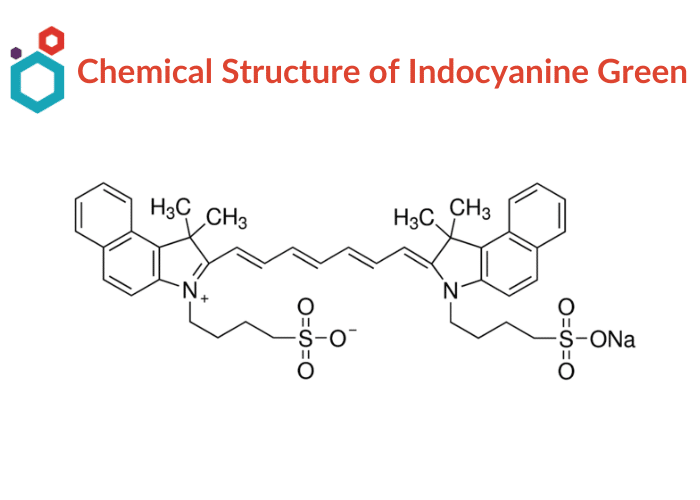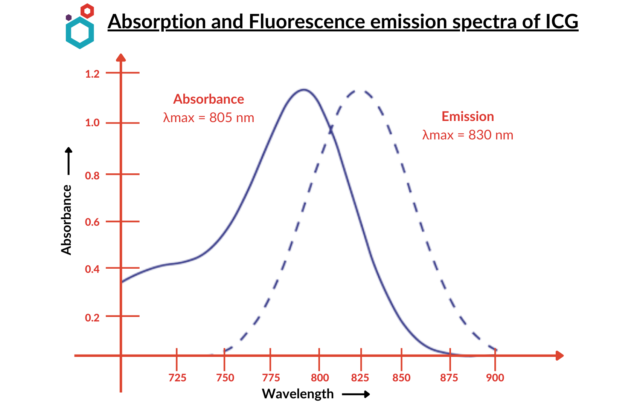Home » Blog » Indocyanine Green »
Table of Contents
What is Indocyanine Green
Indocyanine green or Indocarbocyanine is a nontoxic, fluorescent tricarbocyanine dye used in medical diagnostics. It is used to measure cardiac output (heart function) and liver blood flow. In medical procedures such as angiography, it can also be used to make certain parts of the eye more visible.
Besides uses in cancer treatment, indocyanine green injections are used to identify or detect problems with liver blood flow, tissue perfusion, and blood vessels before, during, or after surgery or to diagnose or find problems with lymph nodes in the cervix, or to diagnose or treat lymphomatous diseases of women with uterus or cervix tumours.

Chemical properties

- Indocyanine Green is a tricarbocyanine dye with a molecular formula C43H47N2NaO6S2 and a molecular weight of 775 daltons.
- It occurs as a dark green to blue-green solid, while its solution is deep emerald-green in colour.
- The chemical name for Indocyanine Green is 1-H-Benz[e]indolium or 2-[7-dihydro-1,1-dimethyl-3-(4-sulfobutyl)-2H-benz[e]indol-2-ylidene]-1,3,5-Heptatrienyl]-1,1-dimethyl-3-(4-sulfobutyl)-, hydroxide, inner salt, sodium salt.
- It is generally odourless or has a slight odour.
- It absorbs best at 800 nm.
- Indocyanine Green solubility – It is soluble in water and in methanol but practically insoluble in most other organic solvents.
- It decomposes gradually above 200 °C.
- The pH of ICG for Injection USP is 6.5 when reconstituted.
Optical Properties
Indocyanine green (ICG) is a negatively charged, water-soluble tricarbocyanine dye whose absorption and fluorescence spectra are dependent on the concentration and on the solvent utilized. ICG’s absorption and fluorescence spectra are in the near infrared (NIR) range. It absorbs mainly between 600 nm and 900 nm (mainly around 780 nm) and emits fluorescence between 750 nm and 950 nm. Since the fluorescence spectrum is so broad (max. values ranging to 810 nm in water and approx. 830 nm in blood) , the substantial overlap between the absorption and fluorescence spectra results in a significant reabsorption of fluorescence by ICG itself.

How does Indocyanine Green work
ICG is a nontoxic dye, which is exclusively metabolized by the liver in humans. Following an intravenous infusion at a rate ( R ) below the metabolic capacity of the liver, a steady state is reached within 1 h. ICG levels are then measured in the hepatic vein (HV) and peripheral blood. As ICG is not metabolized anywhere else, the ICG concentration in peripheral blood is equivalent to that in the hepatic artery (HA) or the portal vein (PV). Therefore, hepatic blood flow can be calculated by the Fick principle: Flow = R /(ICG Peripheral – ICG HV ).
Also, ICG has the property of fluoresces, i.e. emits light, after excitation under near-infrared light at 806 nm light. ICG is highly soluble in water and binds to β-lipoproteins, particularly to albumin. Because of the high protein content of lymph, ICG accumulates in the lymphatic pathways and lymph nodes. ICG-dyed lymph nodes become visible 5 minutes after light excitation and remain visible for around 60 minutes. Thus, Indocyanine Green is used in Fluorescence Imaging with Near-Infrared Light to Identify Sentinel Lymph Nodes, Lymphatic Vessels and Pathways Prior to Surgery.
Uses of Indocyanine green
Indocyanine green (ICG), the only FDA-approved cyanine dye, has been used for decades as a non-targeting contrast agent for optical imaging in opthalmic angiography. Besides this, it is a prescription medicine used as a diagnostic agent for determining Cardiac Output, Hepatic Function and Liver blood flow. The various applications of Indocyanine green are discussed below in detail.

Indocyanine green angiography
Indocyanine Green Angiography (ICGA) is a diagnostic procedure that uses ICG dye to examine the blood flow in the CHOROID – the layer of blood vessels which lies underneath the retina. The choroid is the layer of blood vessels and connective tissue between the sclera (white of the eye) and retina. It supplies nutrients to the inner parts of the eye.
The procedure is similar to fluorescein angiography. Indocyanine Green dye is injected into a vein in the arm/hand. Each vial of Indocyanine Green for Injection USP comprises 25 mg of Indocyanine Green as a sterile lyophilized powder containing less than 5% sodium iodide. As the dye passes through the blood vessels of your eye, photographs are taken to record the blood flow. The Indocyanine Green dye is generally tolerated without any problems. The most common application of indocyanine green angiography is the detection of choroidal neovascularization, a common component of age-related macular degeneration. Refer here to know more.
Capsulorhexis
Capsulorhexis is performed through cataract surgery to remove the lens capsule. The lens capsule is stained with various dyes during the procedure. Horiguchi et al. described the first use of indocyanine green dye for staining capsular tissue in 1998. During childhood cataract surgery, ICG-enhanced anterior and posterior capsulorhexis can be beneficial. Adult cataracts without fundus glow might also benefit from ICG-enhanced capsulorhexis. US FDA has approved ICG, but no approval has been given for intraocular use.
Perfusion diagnostics of tissues and organs
Blood flow to tissues and organs can be assessed using this method in many medical fields. Using a camera attached directly to a near-infrared light source, the fluorescence can be excited. In real-time, ICG fluorescence can be viewed and documented with a digital video camera. In addition, ICG can also be used as a tracer in cerebral perfusion diagnostics. Fluorescence and ICG absorption measurements can be used in everyday clinical settings to monitor stroke patients during the recovery phase.
Indocyanine green lymphography
Indocyanine green (ICG) lymphography is an emerging imaging technique used to visualize lymphatic vessels and map their course as they drain to sentinel lymph nodes. ICG has become an alternate popular method for imaging lymphatics. ICG lymphography was initially used for breast sentinel node biopsy. Its application then extended to lymphoedema diagnosis and mapping of lymphatic vessels prior to lymphovenous anastomosis (LVA) surgery. Gastric cancer lymphatic drainage can also be visualized using indocyanine green (ICG) fluorescence lymphography.
Sentinel lymph node biopsy while undergoing tumour removal with ICG
It is a minimally invasive method of assessing whether malignant tumours have spread to local lymph nodes using a sensitized lymph node biopsy (SLN biopsy). In the first lymph node, the “sentinel”, there may be a tumour of the entire lymph node area that is draining and not present elsewhere. The ICG fluorescence navigation method is highly sensitive and offers high rates of detection. Even though the new method presents a difficult learning curve, it combines lymphography and SLB, making it possible to perform an SLB without the use of radioactive substances.
Selectively over-heating cells (especially cancer)
Indocyanine Green absorbs light at wavelengths of about 805 nanometers, along with other near-infrared wavelengths. Using an 800 nm to 810 nm laser, it is possible to heat or overheat ICG-injected tissue without damaging surrounding tissues. ICG kills cells primarily through overheating. Tumours naturally absorb more ICG than other tissues, so it works particularly well on cancer tumours.
Side Effects of Indocyanine Green
Medicine may also have some unwanted effects, in addition to its needed effects. It is possible that some of these side effects are not experienced, but if they do, medical treatment may be required.
- Cough
- Difficulty with swallowing
- Dizziness
- Excessive sweating
- Headache
- Fast heartbeat
- Hives or welts
- Itching or rash on the skin
- Swollen lips, face, or tongue
- Tightness in the chest
- Fatigue, or low energy
Other side effects not listed may also occur in some patients. If any of the following side effects occur, speak with your doctor or nurse as soon as possible.
Precautions while using Indocyanine green
- It is very important that your doctor checks your or your child’s progress to make sure this medicine is working properly and to check for unwanted effects.
- Anaphylactic reactions, such as anaphylaxis, can result from using ICG. Symptoms of ICG may include rashes, itching, swelling of your face, tongue, and throat, difficulty breathing or swallowing, and chest pain. Reach out to your doctor if you experience anything odd or out of the symptoms.
- Make sure any doctor or dentist who treats you knows that you are receiving this medicine. This medicine may affect the results of certain medical tests.
- Consult your doctor before taking any other medicines. Medications covered include prescriptions, over-the-counter (OTC) medications, herbal supplements, and vitamins.
FAQs
Where to buy Indocyanine green (ICG)?
Macsen Drugs, a unit of Macsen Labs, is one of the leading cGMP manufacturers and suppliers of Indocyanine green with WHO-GMP Certification and USFDA registration.
What is the difference between Fluorescein and Indocyanine Green angiography?
ICG dye has a high protein binding capacity (about 98%) and thus can image the choroidal vasculature better than fluorescein angiography. To know more in detail you may refer here.
How long does Indocyanine green stay in your system?
Indocyanine Green stays in the vessels for up to 30 minutes due to its binding to plasma proteins (intravenously). In an eye examination, blood stays for a long time in tissues with higher blood flow, like the choroid and the retinal blood vessels.
When do you give Indocyanine green?
PINPOINT Endoscopic Fluorescence Imaging System for laparoscopic cholecystectomy showed that the optimal timing of indocyanine green administration for fluorescent cholangiography was 15 hours before surgery.
How do you take Indocyanine green?
Indocyanine green is administered as a rapid IV bolus for hepatic function studies.
What is the half-life of ICG dye?
ICG has a half-life of between 150 and 180 seconds and is eliminated from circulation entirely by the liver through the production of bile juice.
Does Indocyanine green contain Iodine?
Yes, indocyanine green (ICG) contains iodine. Because of its iodine component, testing for iodine intolerance must be carried out before injecting the dye to prevent the risk of anaphylaxis or other allergic reactions. Indocyanine green is contraindicated in patients who are hypersensitive to iodine or other substances that contain iodine such as shellfish or X-Ray dye.
Is Indocyanine green Nephrotoxic?
ICG is non-nephrotoxic, excreted exclusively by the liver, with incidences of minor and major complications being exceedingly rare.
Who manufactures ICG?
Macsen Labs is a GMP and ISO-certified manufacturer of high-quality indocyanine green.
Is Indocyanine green (ICG) a dark fluorophore?
Indocyanine Green is a fluorescent tricarbocyanine dye used in medical diagnostics. It absorbs mainly between 600 nm and 900 nm and emits fluorescence between 750 nm and 950 nm.
Is ICG FDA approved?
Indocyanine green is an FDA-approved dye.
What is Indocyanine Green made of?
Indocyanine Green Injection USP comprises 25 mg of Indocyanine Green as a sterile lyophilized powder containing less than 5% sodium iodide.
Who invented ICG?
In 1955, the Kodak research laboratories created ICG dye for near-infrared (NIR) photography, and in 1959, the FDA approved its clinical usage.
What is cholecystectomy with ICG?
Cholecystectomy with ICG involves its uses during laparoscopic cholecystectomy (gall bladder removal) for a better understanding of the anatomy of the biliary tree and to prevent or reduce the risk of bile duct injury.
What is the frequency at which ICG emits light?
ICG absorbs mainly between 600 nm and 900 nm and emits fluorescence between 750 nm and 950 nm.
Resources on Indocyanine Green
Indocyanine Green Injection for Angiography
Indocyanine Green | Uses in Medical Imaging & Surgery
Disclaimer-
The information provided here is based on general knowledge, articles, research publications etc and we do not claim the authenticity of any of the information provided above. We do not claim or suggest/advise any medical, therapeutic, health or nutritional benefits of Indocyanine green. We do not supply or promote our Indocyanine green product for the applications which are covered by valid patents and which are not approved by the FDA.
Macsen Labs is a manufacturer and supplier of high-quality Indocyanine Green.


